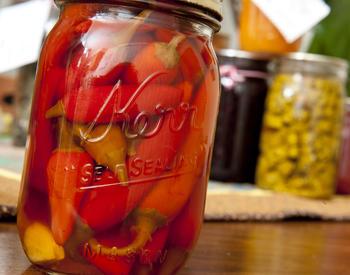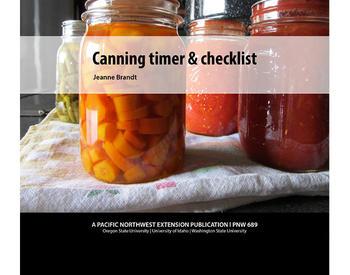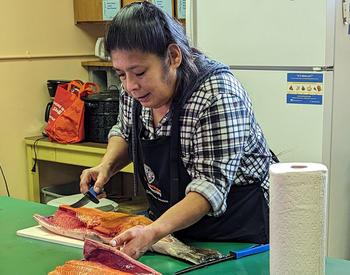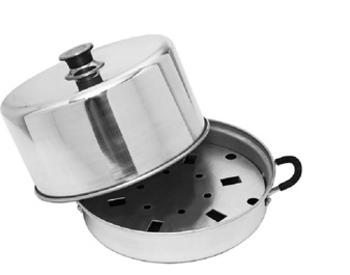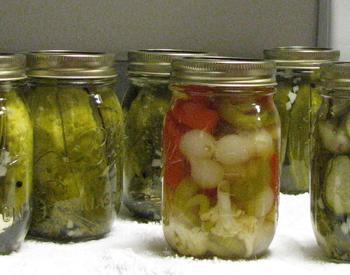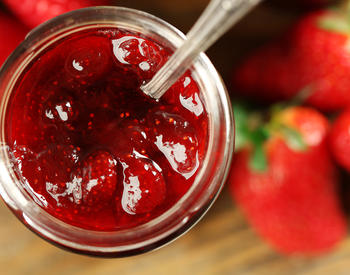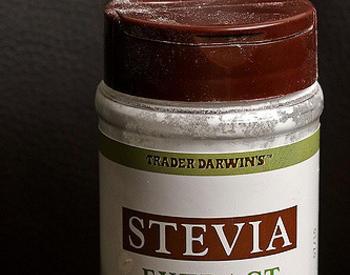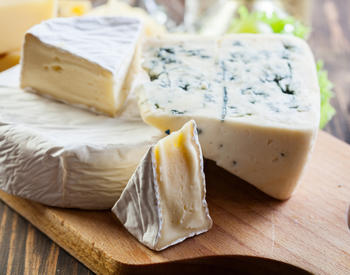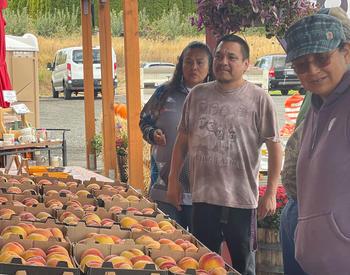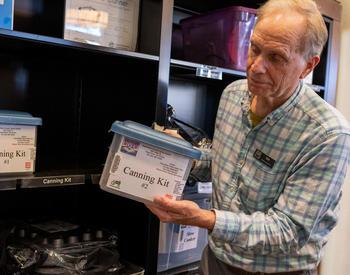Download this publication as a PDF
Jams, jellies, preserves and marmalades can add zest to meals and are a good way to use fruits that are not suitable for canning and freezing. Fruit spreads are all preserved with sugar and are gelled to some extent. Individual characteristics depend on:
- The type of fruit used.
- How it is prepared.
- The proportion of different ingredients.
- The method of cooking the spread.
Jelly is made from fruit juice; the product is clear and firm enough to hold its shape when turned out of the container.
Jam is made from crushed or ground fruit. It holds its shape, but generally is less firm than jelly.
Conserves are jam-like products that are made from a combination of fruit and usually contain nuts, raisins or coconut.
Preserves are made from small, evenly sized pieces of whole fruit and suspended in a thick or slightly gelled syrup.
Marmalades are soft fruit jellies containing small pieces of fruit or peel suspended in a clear jelly. Marmalades usually contain citrus fruit and/or peels.
Butters are spreads made by thickening sweetened fruit pulp and often have spices added. Not all fruits have the properties needed for making satisfactory gelled products, but with the commercial pectins on the market, most fruits can be made into successful fruit spreads.
Essential ingredients
In order to make successful fruit spreads (not low in sugar), four essential ingredients in the right proportion are needed in order for a gel to form.
Fruit
Fruit gives the spread its special flavor and furnishes part of the pectin and acid needed to form the gel. Fruit spreads can be made from fresh and unsweetened frozen and canned fruits. Flavorful varieties of fruits are best for gelled products because the fruit flavor is diluted by the large proportion of sugar necessary for proper consistency and good keeping quality.
Pectin
Pectins are natural substances found in varying amounts in fruit. It is the pectin that causes the jam and jelly to gel. Fruit that is slightly underripe contains more pectin than fully ripe fruit.
Cores and seeds are high in pectin and are often included in the recipe for preparing fruit or juice spreads. Fruits high in pectin and also in acid include tart apples, Concord grapes, sour blackberries, cranberries, currants, gooseberries, raspberries and sour plums.
Fruits considered low in pectin are apricots, blueberries, sweet cherries, peaches, pineapple, rhubarb and strawberries.
Commercial pectins1
Commercial pectins can be used with any fruit. Many people prefer to use commercial pectins for making spreads because fully ripe fruit can be used, the cooking time is shorter and there is no question when the product is done.
There are two types of regular commercial pectins on the market — liquid and powdered. The liquid pectin (Certo and Ball) is made from apples, and the powdered pectins (Sure-Jel, MCP, Mrs. Wages, and Ball 100% Natural Fruit Pectin) are made from citrus fruits. Either form is satisfactory when used in a recipe developed especially for it. The powdered and liquid forms are not interchangeable.
Special pectins are available for making low- or no-sugar products. (See Low-Sugar Fruit Spreads, SP 50-765.) Products will fail to gel if sugar is reduced in traditional recipes using liquid or powdered commercial pectin.
Acid
Acid is needed for flavor and gel formation. The acid content varies in different fruit and is higher in underripe fruit. With fruits that are low in acid, lemon juice is added to the recipes. If there is too little acid, the product will not gel; if there is too much acid, the gel will weep. Commercial pectin products have powdered acid added to them to assure gelling. Some recipes require additional lemon juice because of the acidity level of the fruit.
Sugar
Sugar helps in gel formation and serves as a preserving agent. It also contributes to the flavor and color of the jellied products. The amount of sugar is an important part of the gelling formula.
Sugar must be present in the right proportion with acid and pectin in order to form the gel. It is the preservative for the product, thereby preventing the growth of microorganisms. Both cane and beet sugars can be used. Do not reduce the amount of sugar in a recipe unless you are using one of the low-sugar pectin products.
Other sweeteners
Honey
Light, mild-flavored honey can be used to replace part of the sugar in jelly-making. Its liquid content needs to be considered. In products made with added pectin, up to 1 cup of honey can replace an equal quantity of granulated sugar when making regular spreads from commercial pectin. Honey can replace up to one-half of the sugar in recipes with no added pectin.
The texture and flavor of the fruit spread may be altered by using honey. Some “all honey” recipes are available from commercial pectin companies.
Alternative sweeteners
The OSU Extension Service does not promote the use of artificial sweeteners in food preservation. Commercial low-sugar pectin products provide recipes and instructions for making jams and jellies using alternative sweeteners.
Equipment
For preparing the fruit spreads
- An 8–10 quart kettle with a broad flat bottom.
- Jelly bag (square yard of unbleached muslin) or flour sack tea towels if jelly bags are not available.
- A jelly bag stand or cone strainer to hold jelly bag.
Other kitchen equipment such as:
- Quart glass measuring cup.
- Dry measuring cups and spoons.
- Paring knives.
- Potato masher.
- Bowls.
- Colander.
- Long-handled spoon.
- Ladle.
- Small dish.
- Metal spoon for skimming foam from cooked product.
- Timer.
- Household scales.
For processing
- One-quarter, one-half or pint canning jars with standard two-piece lids and rings.
- Boiling water canner or large kettle with rack in bottom that is tall enough to get 1 inch of water over the top of jars; jar lifter to take jars out of boiling water; and a rack or towel to set jars on to cool.
Preparing
To have jellied fruit spreads at their best, make only as much as you can use within a few months. Preserves stored for longer times lose their flavor and bright color.
Follow directions that come with the commercial pectin packages exactly and be accurate in measuring. Never double recipes. Large quantities take too long to heat and the pectin will break down, which can result in a runny product.
Filling jars/processing
Prepare the canning jars before you start to make the jellied product. Check for cracks, chips or defects that will prevent sealing. Wash jars in hot, soapy water and rinse. Sterilize by boiling for 10 minutes if the product will be processed less than 10 minutes. If the processing time is longer than 10 minutes, sterilizing the jars is not necessary. Keep the jars hot until ready to use.
Follow manufacturer's directions for preparing lids. Headspace for jams, jellies and fruit spreads is one-quarter inch unless the recipe specifies otherwise.
Process all jelled products in a boiling water canner to prevent mold growth. Place jars in a boiling water canner, covering jars with 1 inch of water. Bring to a boil and start counting the processing time. After processing, take canner off heat. Remove lid. Wait 5 minutes before removing jars. Note: Paraffin is no longer recommended because of the high spoilage rate when used.
Storing
Let the products stand undisturbed for 12 hours to allow the gel to form. After the product has cooled, check the seal, remove the screw band, wash jars, label and store in a cool, dark, dry place. Remember that the shorter the storage time, the better eating quality of the product.
Related Publications
- Jams, Jellies and Preserves With No Added Pectin
- Low-Sugar Fruit Spreads
- Problems and Solutions With Jams and Jellies
Source: OSU Master Food Preserver Program
- 1Reference to commercial pectin products in this publication is not intended as an endorsement of the products. It is important to follow the manufacturer's instructions for each product.
